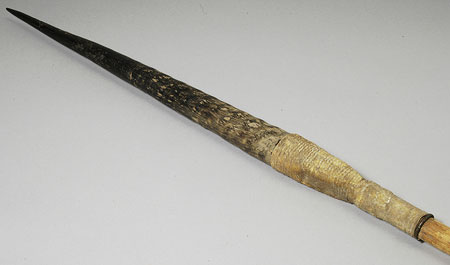Accession Number:
1973.16.2
Country:
Sudan
Region:
[Southern Sudan]
Cultural Group:
Mandari
Date Made:
By the end of 1950s
Materials:
Wood Plant , Animal Hide Skin , Animal Horn , Brass Metal
Process:
Carved , Polished , Covered , Tooled , Decorated Impressed , Bent
Dimensions:
Preserved L = 1285; visible part of spear-head = 476; max W = 44, max th = 38.2; sheath L = 177; shaft diam = 24.3 x 25; brass ring diam = 31.5, th = 4 mm [RTS 26/7/2005].
Weight:
429.4 g
Other Owners:
Collected by Jean Carlile Buxton, then bequeathed to Ronald Godfrey Lienhardt
Field Collector:
Jean Carlile Buxton
PRM Source:
Ronald Godfrey Lienhardt
Acquired:
Donated 20 February 1973
Collected Date:
1950s
Description:
Spear consisting of a narrow, straight point made from polished dark brown horn with a naturally ridged surface and oval section (Pantone black 7C).
The base of this appears to have had 2 flat sections shaved from its sides, before joining with a long narrow shaft of yellow wood (Pantone 7509C), more circular in section, and with its lower end sheared off and missing, something that was probably done by the collector to facilitate transportation.
The junction between these two parts is covered with 2 overlapping cylindrical sheaths, cut from sections of animal tail with the hair removed.
These were stretched over the body whilst wet and then shrunken in place, obscuring the exact manner by which the spearhead is secured.
The upper sheath is a yellowish brown colour (Pantone 7509C) and covers the shaved part of the spearhead, and has been tooled in rows around its circumference, leaving faint angled lentoid-shaped impressions.
Its lower part fits inside the second sheath, whose surface has been left undecorated.
A brass ring has been fitted over the top of the shaft just below, made from a rod bent into a loop with the ends slightly apart.
The spear is incomplete; the surface of the horn section is covered with pitting, while there are some splits in the surviving lower part of the wooden shaft.
It has a weight of 429.4 grams and a preserved length of 1285 mm.
The visible part of the spearhead is 476 mm long, with a maximum width of 44 mm and thickness of 38.2 mm; the 2 hide sheaths have a combined length of 177 mm, the brass ring measures 31.5 mm in diameter and is 4 mm thick, while the wooden shaft has a diameter of 24.3 by 25 mm.
Collected by Jean Carlile Buxton, then bequeathed to Ronald Godfrey Lienhardt; it was subsequently donated to the Pitt Rivers Museum in 1973.
Spears tipped with straight, or straightened animal horn are also used by the Nuer (see 1931.66.9 and 1936.10.1), Dinka (1913.15.5) and Shilluk (1919.13.17-18, 1929.58.1), usually using materials such as antelope or onyx. The Nuer hafted these points as follows: 'The giit ... is fixed at the joint with an unsewn leather collar made from the tail skin of an ox. This is soaked and stretched round the haft, where it shrinks as it dries' (P.P. Howell, 1947, "On the Value of Iron Among the Nuer", Man 47, p. 132-3).
Rachael Sparks 30/9/2005.
Collected by Jean Carlile Buxton, then bequeathed to Ronald Godfrey Lienhardt; it was subsequently donated to the Pitt Rivers Museum in 1973.
Spears tipped with straight, or straightened animal horn are also used by the Nuer (see 1931.66.9 and 1936.10.1), Dinka (1913.15.5) and Shilluk (1919.13.17-18, 1929.58.1), usually using materials such as antelope or onyx. The Nuer hafted these points as follows: 'The giit ... is fixed at the joint with an unsewn leather collar made from the tail skin of an ox. This is soaked and stretched round the haft, where it shrinks as it dries' (P.P. Howell, 1947, "On the Value of Iron Among the Nuer", Man 47, p. 132-3).
Rachael Sparks 30/9/2005.
Primary Documentation:
Accession Book Entry
- 1973.16 G[ift] DR.
R.
G.
LIENHARDT, INSTITUTE OF SOCIAL ANTHROPOLOGY, UNIVERSITY OF OXFORD, 51 BANBURY RD.
- AFRICA SOUTHERN SUDAN MANDARI DISTRICT.
Spear head and part of shaft (rest of shaft broken off).
Shaft of light wood.
Head of polished and pointed horn, bound onto shaft by pieces of gut and hide.
There is a brass ring around the shaft just below the hide binding.
Present L = 137 cm.
[followed by discussion of both 1973.16.1 and .2] The spears were collected by Dr.
J.
C.
Buxton in the 50's.
he bequeathed a set of spears, of which these are two, to the donor.
Donated February 20, 1973.
[initialled] LW.
Additional Accession Book Entry - [on facing page] all cards done.
Additional Accession Book Entry - [in red biro under accession number] A5-F21-24.
Card Catalogue Entry - There is no further information on the catalogue card [RTS 28/1/2004].
Pitt Rivers Museum label - AFRICA, Southern Sudan. MANDARI tribe. Spear with horn point. Coll. J.C. Buxton. d.d. R.G. Lienhardt, 1973.16.2 [plastic coated label, tied to object; RTS 26/7/2005].
Written on object - S. SUDAN - MANDARI. 1973.16.2 [RTS 26/7/2005].
Additional Accession Book Entry - [on facing page] all cards done.
Additional Accession Book Entry - [in red biro under accession number] A5-F21-24.
Card Catalogue Entry - There is no further information on the catalogue card [RTS 28/1/2004].
Pitt Rivers Museum label - AFRICA, Southern Sudan. MANDARI tribe. Spear with horn point. Coll. J.C. Buxton. d.d. R.G. Lienhardt, 1973.16.2 [plastic coated label, tied to object; RTS 26/7/2005].
Written on object - S. SUDAN - MANDARI. 1973.16.2 [RTS 26/7/2005].



